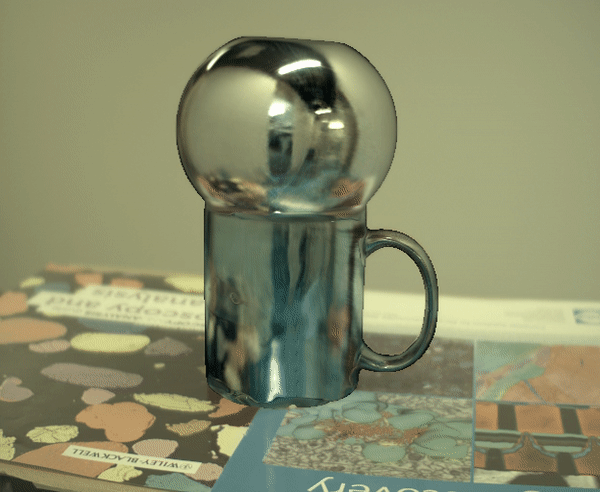Science Fiction
Dictionary
A B C D E F G H I J K L M N O P Q R S T U V W X Y Z
MIT And Rice Create Blade Runner Photo Analysis

Can any shiny object become a camera? MIT and Rice University researchers think so.

(All it needs now is voice controls...)
researchers from MIT and Rice University have created a computer vision technique that leverages reflections to image the world. Their method uses reflections to turn glossy objects into “cameras,” enabling a user to see the world as if they were looking through the “lenses” of everyday objects like a ceramic coffee mug or a metallic paper weight.Using images of an object taken from different angles, the technique converts the surface of that object into a virtual sensor which captures reflections. The AI system maps these reflections in a way that enables it to estimate depth in the scene and capture novel views that would only be visible from the object’s perspective. One could use this technique to see around corners or beyond objects that block the observer’s view.
This method could be especially useful in autonomous vehicles. For instance, it could enable a self-driving car to use reflections from objects it passes, like lamp posts or buildings, to see around a parked truck.
“We have shown that any surface can be converted into a sensor with this formulation that converts objects into virtual pixels and virtual sensors. This can be applied in many different areas,” says Kushagra Tiwary, a graduate student in the Camera Culture Group at the Media Lab and co-lead author of a paper on this research.
(Via MIT)
In the 1982 film Blade Runner by Ridley Scott (taken from Do Androids Dream of Electric Sheep by Philip K. Dick), the replicant hunter played by Harrison Ford uses an Esper photo analysis device to perform an amazing enhancement of an ordinary photograph.
(From Blade Runner)
Scroll down for more stories in the same category. (Story submitted 4/29/2023)
Follow this kind of news @Technovelgy.| Email | RSS | Blog It | Stumble | del.icio.us | Digg | Reddit |
Would
you like to contribute a story tip?
It's easy:
Get the URL of the story, and the related sf author, and add
it here.
Comment/Join discussion ( 0 )
Related News Stories - (" Engineering ")
Tornyol Microdrone Kills Mosquitoes
'The real border was defended by... a swarm of quasi-independent aerostats.'
PLATO Spacecraft, Hunter Of Habitable Planets, Now Ready
'I ... set my automatic astronomical instruments to searching for a habitable planet.' Edmond Hamilton (1936).
Did The Yautja Have These First?
What a marvel of ingenuity the little device was! - Harry Bates, 1934.
Jetson ONE Air Races Begin, Can Air Polo Be Far Behind?
'If you're one of those rarities who haven't attended a rocket-polo "carnage", let me tell you it's a colorful affair.' - John Victor Peterson, 1938.
Technovelgy (that's tech-novel-gee!) is devoted to the creative science inventions and ideas of sf authors. Look for the Invention Category that interests you, the Glossary, the Invention Timeline, or see what's New.
Science Fiction
Timeline
1600-1899
1900-1939
1940's 1950's
1960's 1970's
1980's 1990's
2000's 2010's
Current News
Natural Gait With Prosthetic Connected To Nervous System
'The leg was to function, in a way, as a servo-mechanism operated by Larry’s brain...'
Woman Marries Computer, Vonnegut's Dream Comes True
'Men are made of protoplasm... Lasts forever.'
Spidery 'Walk Me' Toyota Autonomous Wheel Chair Like Star Wars
Walk along with the emperor.
Dancing Robots Taught Dance Moves
'A clockwork figure would be the thing for you...'
Proof Of Robothood - Not A Person
'Who are you people? - Show 'em.'
Indonesian Clans Battle
'The observation vehicle was of that peculiar variety used in conveying a large number of people across rough terrain.'
The 'Last Mile' In China Crowded With Delivery Robots
Yes, it's a delivery robot. On wheels.
Tornyol Microdrone Kills Mosquitoes
'The real border was defended by... a swarm of quasi-independent aerostats.'
PLATO Spacecraft, Hunter Of Habitable Planets, Now Ready
'I ... set my automatic astronomical instruments to searching for a habitable planet.'
Factory Humanoid Robots Built By Humanoid Robots
'...haven't you a section of the factory where only robot labor is employed?'
iPhone Air Fulfils Jobs' Promise From 2007 - A Giant Screen!
'... oblongs were all over the floor and surfaces.'
ChatGPT Now Participates in Group Chats
'...the city was their laboratory in human psychology.'
iPhone Pocket All Sold Out!
'A long, strong, slender net...'
Did The Yautja Have These First?
What a marvel of ingenuity the little device was!
Jetson ONE Air Races Begin, Can Air Polo Be Far Behind?
'If you're one of those rarities who haven't attended a rocket-polo "carnage", let me tell you it's a colorful affair.'
Will Space Stations Have Large Interior Spaces Again?
'They filed clumsily into the battleroom, like children in a swimming pool for the first time, clinging to the handholds along the side.'
